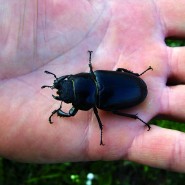
It’s the time of year when the splendid stag beetle is emerging to find a mate.
The beetles spend the first five to seven years of their life underground and only live until the end of August as adults.
They’re also seriously endangered. So if you see one, don’t be alarmed – and definitely don’t tread on them!
Here are some things to know:
1. The Stag Beetle is our largest native ground-dwelling beetle. Adult females can be up to 5cm long and some males may reach 7cm.
2. The male stag beetle has large jaws that look a bit like the antlers of a deer – hence its name. Females have smaller mandibles but are much stronger.
3. Male Stag Beetles use their antlers to wrestle during the mating season. The winner throws the loser to the ground.
4. Stag Beetle larvae are really good for your garden. They eat loads of rotting wood, returning important minerals to the soil, but don’t eat living plants or shrubs.
5. If you have found stag beetle larvae – they are white coiled grubs that can be as big as a £2 coin – please rebury them with some wood and soil in a shady undisturbed area. They spend up to seven years at this stage so it’s really important to look after them!
6. Stag Beetles can fly – and often go out to look for a mate at dusk. You may see adult stag beetles on pavements, when they’ve landed from one of their distinctive upright flights, which sound a bit like a tiny fighter plane.
7. If you find one, you can give them some soft fruit or sugared water and move it out of harms way. Don’t put your finger between the ‘antlers’ but if you pick them up (gently) on their body you can move them out of harm’s way.
8. Other names for stag beetles were billywitches, oak-ox, thunder-beetle and horse pincher. Old stories said they could summon thunder and lightning – possibly because they are often seen flying on warm thundery nights.
9. The People’s Trust for Endangered Species is particularly keen to hear from people who see stag beetles in the New Forest. https://ptes.org/